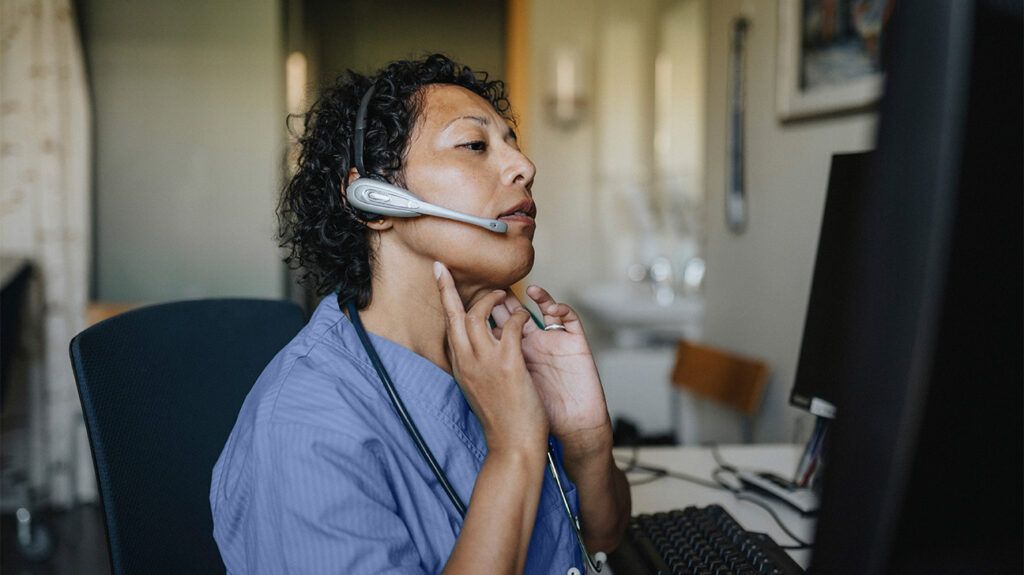Telemedicine offers a convenient way to access healthcare services, including obtaining prescriptions, without physically visiting a doctor’s office. Consultations can take place over the phone or using video.
Telemedicine provides online prescriptions by enabling healthcare professionals to conduct virtual consultations to assess a person’s condition.
After evaluating symptoms and medical history, the healthcare professional can diagnose the condition and, if appropriate, issue an electronic prescription. This e-prescription goes directly to a pharmacy that a person chooses, where the medication can be filled for pickup or delivery.
Through telemedicine, people can access necessary prescriptions conveniently without needing an in-person visit.

Telemedicine has many benefits over visiting a doctor’s office in person.
Convenience
Telemedicine
With telemedicine, people can often schedule appointments more quickly, sometimes even on the same day, without the long wait times typically associated with in-person visits.
For those with busy schedules, telemedicine appointments are a practical solution. They allow people to fit medical consultations into their day without taking time off work or arranging child care.
Specialized care
Telemedicine expands
Those with chronic conditions or ongoing medical needs can maintain regular check-ins with their healthcare professionals. This helps ensure consistent and continuous care without the hassle of frequent office visits.
Telemedicine makes obtaining second opinions from specialists easier, allowing people to make more informed decisions about their health by consulting experts in different locations.
Insurance coverage
Many insurance companies
Telemedicine
In addition to insurance coverage, many telemedicine platforms offer flexible payment options, including pay-per-visit models, making it accessible even for those without comprehensive insurance plans.
Find out about Medicare’s coverage of telehealth.
Support
Many telemedicine platforms actively enhance the healthcare experience by pairing a person with a care coordinator or care team. These teams ensure that individuals receive comprehensive support throughout their treatment journey.
Before a virtual visit, a care coordinator or care team member contacts the person to help prepare. They assist in gathering
The support team collects details such as the person’s photo ID, insurance information, pharmacy preferences, and medical history. This ensures that the healthcare team has all the necessary information to make an informed diagnosis and treatment plan.
After the virtual consultation, the care coordinator
The care team can also help people find cost-saving options for their medications. Whether the person has insurance or pays out-of-pocket, they explore alternatives such as generic medications, pharmacy discounts, or assistance programs to reduce costs.
People can often refill a prescription online without seeing a doctor in person. Many healthcare teams and pharmacies offer online refill services, particularly for chronic conditions requiring ongoing medication.
If the prescription is for a medication the person has been taking regularly, the doctor may approve a refill according to their medical history and previous consultations.
In many cases, people can request a refill through a telemedicine platform or directly from the pharmacy’s website, making the process quick and convenient without needing an in-person visit.
To get started with telemedicine, people can follow these steps:
Choose a telemedicine platform
Individuals can begin by selecting a telemedicine platform that suits their needs. This could be through an independent telemedicine service or by contacting their existing healthcare team to see if they offer virtual consultations.
They can consider factors such as ease of use, available specialties, and whether the platform has insurance coverage.
Find the best telemedicine companies.
Create an account
After selecting a platform, the person needs to create an account. This involves providing basic information such as name, contact details, and medical history.
Ensuring all information is accurate facilitates a smooth consultation process.
Schedule an appointment
Once a person has set up their account, they can schedule an appointment by choosing a convenient time and date from the available slots on the platform.
Many platforms offer flexibility, allowing quick appointment scheduling, sometimes on the same day.
Prepare for the appointment
Before the appointment, if there is to be a face-to-face video consultation, the person
Finding a quiet space for the consultation is helpful to ensure clear communication with the healthcare professional and ensure privacy.
Conduct the consultation
During the virtual consultation, the person will discuss their symptoms, concerns, and medical history with the healthcare professional.
The doctor will use this information to make a diagnosis, recommend treatment, or prescribe medication as necessary.
Access prescribed medications
If a prescription is necessary, the doctor will issue an electronic prescription (e-prescription), which goes directly to the person’s chosen pharmacy.
It is unlikely that healthcare professionals can prescribe controlled substances via telemedicine. They may require a person to meet face-to-face with a doctor.
Depending on the pharmacy’s services, the individual can pick up the medication in person or opt for home delivery.
Telemedicine can be an efficient and effective way to get a prescription online, providing a safe and convenient option for managing many health conditions without the need for an in-person visit.


